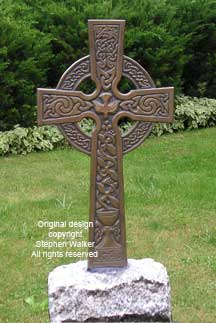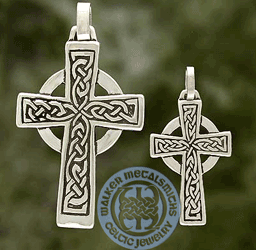Is the Celtic Cross a Pagan Symbol?
|
Many claim it is, especially Neo-Pagans, who now use it freely for their own
purposes. Some Christians, especially fundamentalists, are terribly afraid that
they might be right and want nothing to do with it if it is tainted by Pagan
associations. But the vast majority who use the Celtic Cross are Christian and
unconcerned that there is any controversy.
All the historical examples of actual "Celtic Crosses" are from indisputably
Christian contexts. The Aberlemno Stone in Angus, the great High Crosses at
Clonmacnoise, Monasterboise, Kells, Iona and many other medieval monastic sites
are all clearly made in Christian times, under Christian patronage and according
to conventional Christian iconography. So where does this claim of paganism come
from?
Henry O'Neill, in his 1857 book Illustrations of the Most Interesting of
the Sculptured Crosses of Ancient Ireland writes, "I think that ancient
Irish art was pagan, and was continued during the Christian period, just as the
peculiar form of the Irish cross is pagan, or as the names of the months, or of
the days of the week are pagan; these, and a great deal more of paganism, having
continued, owing to the tenacity with which a people retain their general habits
and ideas." |

|
O'Neill was not himself pagan, as much of his writing contains a Christian
piety that would refute such a suggestion. Rather he is expressing pride in a
noble antiquity for Irish art. During the 19th century Celtic Revival, much was
said and written about native cultural survivals from pre-Christian times.
"Pre-Christian" would also be pre-Norman and pre-English domination. It must be
remembered that at this time Ireland was reinventing itself. The trauma of
famine and foreign rule was fresh. Many ancient Gaelic myths and legends were
revived to serve the cause of a renewed sense of national identity and pride in
the past.
A renewed interest in Celtic Christianity was part of this movement as well.
The Celtic Church refers to the Church as it was in Ireland and Great Britain in
the early medieval times, when it was considered isolated from Rome and developed
a distinctly Celtic spirituality. People are not of one mind about this, as they
rarely are about religious matters. But one thing that came out of this was the
belief by some that the pagan Druidic religion of the Celts had clairvoyantly
anticipated the Gospels. Legends were retold and refashioned in the light of
emerging ideas and theories from archeology and anthropology. The similarity of
the Celtic Cross to ancient symbols such as various Sun symbols and the swastika
rather firmly established the notion that these pre-Christian signs were
prototypes of the Christian Celtic Cross. The mystics of the movement added this
archeological interpretation to their conviction that God had blessed the Druids
with prophetic knowledge of the coming of Christ.
Some observers see any quartering of a circle as a Celtic Cross. The chambers
of the Neolithic tomb at Newgrange or the arrangement of standing stones.
Examples like these, though they be easily dismissed as coincidence, are
"proof" to some that the Celtic Cross is of greater antiquity than
Christianity and
obviously originally pagan. Setting aside the question of validity of that
belief, let us see what "spin" has been put on that belief in modern
times. To the Celtic Christian of the early 20th century, the pagan roots of
the Celtic Cross were a source of joy and wonder. It is evidence of the
enlightenment and spiritual sensitivity of their pagan ancestors and of
God's grace towards them. Today you are more likely to hear the story told
that the (bad) Christians stole the symbol from its rightful pagan heritage and
that this appropriation was done with the sinister motives of tricking the
convert by changing the meaning of familiar symbols so that his conversion might
require less coercion.
Ironically, the Pagan Roots of the Celtic Cross is essentially a
Christian legend in its development. It is only in the last quarter of the 20th
century that the "Christians stole it" spin of the story has become
widespread, promoted mainly by those who make no secret of their distrust of
Christianity. But there is more irony yet. The negative version of the story is
also spread by some Christians, who unaware of the Celtic Revival version,
believe the Neo-Pagan version of the story as true and feel compelled to spread
the alarm, lest their fellow Christians unwittingly offend God by use of a pagan
symbol.
So my message is "lighten up!" If you are Christian or Pagan
I hope this little essay helps answer some questions. Attempts to deny or taint
the Christian heritage of the Celtic Cross are misguided, but it is also a
mistake to insist that any faith has an exclusive claim on this powerful symbol.
And remember to keep things in perspective. The substance of religion is
faith and love, not symbols.
Stephen Walker
6 October 2002
Other Celtic Cross Resources
Home


